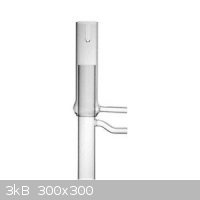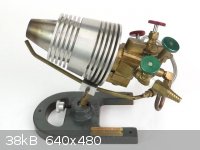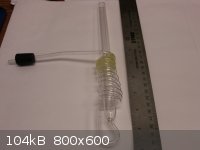497
National Hazard
   
Posts: 778
Registered: 6-10-2007
Member Is Offline
Mood: HSbF6
|
|
Glassblowing
This seems to be a very useful skill for a poor chemistry hobbyist. Does anyone here have experience with it? Is it as hard as it looks? I recently
came across this book, it is very detailed and comprehensive.
Attachment: glassblowing_for_laboratory_technicians_barbour.djvu (2.3MB)
This file has been downloaded 821 times
|
|
|
froot
Hazard to Others
  
Posts: 347
Registered: 23-10-2003
Location: South Africa
Member Is Offline
Mood: refluxed
|
|
I did upload a book on glass blowing to the FTP server, weather it's still there or weather the FTP is still active, I have no idea.
http://www.sciencemadness.org/talk/viewthread.php?tid=2023&a...
How can I open a .djvu file with Vista?
Edit: No worries, I figured it out.
[Edited on 13-6-2008 by froot]
We salute the improvement of the human genome by honoring those who remove themselves from it.
Of necessity, this honor is generally bestowed posthumously. - www.darwinawards.com |
|
|
F2Chemist
Harmless

Posts: 28
Registered: 30-6-2008
Member Is Offline
Mood: No Mood
|
|
Not all that hard, but takes A LOT of practice. For a couple hundred bucks you can get a torch, tanks, eye protection (a must), and other small stuff
to fix/create most joints. Anything larger than ~1" glass tubing really needs a lathe to do a decent job with.
Also, a cheap (although not as good) alternative to an annealing oven is a bucket of perlite. After fixing the joint, put the joint into a bucket of
perlite and it will cool down much slower, thus creating fewer stress point.
|
|
|
JohnWW
International Hazard
    
Posts: 2849
Registered: 27-7-2004
Location: New Zealand
Member Is Offline
Mood: No Mood
|
|
I knew the author of that 1965 book on glassblowing, Robert Barbour, who I think was a British immigrant. For many years he was the chief technician
in the Chemistry Department of Victoria University of Wellington, New Zealand, where I did my first degree in the late 1960s. In 1970, he and Prof.
Alexander T. Wilson left Wellington to found the Chemistry Department at the new Waikato University in Hamilton, New Zealand. Several other Victoria
University Of Wellington Chemistry staff also left about then for Waikato University.
Further information about the book (missing from that DJVU scan of it) is given on http://www.dvd4arab.com/archive/index.php/t-865780.html
but parts of sentences are missing:
2008, 09:46 PM
Glassblowing for laboratory technicians, (Pergamon series of monographs in laboratory techniques)
ISBN: 0080034004
Author: Robert Barbour
Publisher: Pergamon Press
Edition: [1st ed.] edition (1968)
Unknown Binding: 245 pages
URL: /http://www.amazon.com/exec/obidos/redirect?tag=songstech-20&path=ASIN%2F0080034004
Summary:
A Classic "How-To" that deserves to be re-issued, November 26, 2000
Reviewer:
The foreword to my hardcover version was written in 1965 in Wellington, NZ. Perhaps New Zealand
This book does not attempt to get philosophical, whimsical or even overly didactic, yet it contains everything you could want to know about the basics
of glass production and glassblowing for the sciencestock
This is a book that would interest the dilettante who had no intention of ever placing a piece of glass rod or tube near a flame, but who simply
wanted to know more about a totally fascinating process that combines science, art and craftsmanship.
Anyone who has the responsibility for training lab technicians or Science students really should have access to this book. It's a complete classroom
text and training course, but equally suitable for private study by individuals. Anyone leaning towards a more artistic
If one were compiling an encyclopaedia, this single volume would satisfy most folks as the sole entry for "glassblowing".
was not the epicentre of the "swinging 60's" or perhaps people there just valued good, old-fashioned common sense, but this book is like a trip back
to Britain of the 19th century, where the monograph was a highly respected form of writing. control, technique, repair, design, composition and
properties of the most widely-used glasses are all spelled out in a no-nonsense fashion. lab. Safety and health risks, workshop, tools, cleaning,
equipment, ordering, use of glass and glassblowing, would also find the information here of tremendous use.
http://rs46tl.rapidshare.com/files/3511434/glassblowing_for_... 2,314 Kb
|
|
|
len1
National Hazard
   
Posts: 595
Registered: 1-3-2007
Member Is Offline
Mood: NZ 1 (goal) - Italy 1 (dive)
|
|
What a good book - much better than the one in the forum library. Pity I never met him at VUW
|
|
|
S.C. Wack
bibliomaster
    
Posts: 2419
Registered: 7-5-2004
Location: Cornworld, Central USA
Member Is Offline
Mood: Enhanced
|
|
| Quote: | Originally posted by JohnWW
(missing from that DJVU scan of it) |
I have an unexplainable confidence that nothing is missing from the book in the .djvu. And in fact if one bothers to look they will see that that
information is incorrect, as this is the second edition.
There is a hint or two on working with glass in a large number of available chemistry books. One may also search for books on glassblowing and find
books by Heldman (1946), Frary (1914), and Wright (1943). Or not.
|
|
|
franklyn
International Hazard
    
Posts: 3026
Registered: 30-5-2006
Location: Da Big Apple
Member Is Offline
Mood: No Mood
|
|
More on the same
http://www.sciencemadness.org/talk/viewthread.php?tid=8370&a...
.
|
|
|
JohnWW
International Hazard
    
Posts: 2849
Registered: 27-7-2004
Location: New Zealand
Member Is Offline
Mood: No Mood
|
|
Len1,
I think Robert Barbour died in Hamilton, NZ, a couple of years ago; I think I remember seeing his death notice in the NZ Herald.
BTW Prof. Alexander T. Wilson, for whom Robert Barbour constructed a lot of apparatus at both Victoria University of Wellington and Waikato
University, left Waikato for a professorship in Arizona, some years ago, and is still there.
Of the other profs. at VUW, do you remember any of: Prof. James F. Duncan, the Head of the Department and a prof. of inorganic and theoretical
chemistry and radiochemistry, who died a few years ago in retirement in Marlborough; Prof. Neil F. Curtis, prof. of inorganic chemistry and I think
still on the staff; Prof. John L. Tomlinson, physical chemistry (I think he later returned to England); Prof. William E. Harvey, organic chemistry
(later VUW's Registrar), and Prof. Brian D. England, organic chemistry, who suddenly died aged in 1967 aged 45? Also Drs Freeman (inorganic), Craig
(organic), and Cooke?
|
|
|
len1
National Hazard
   
Posts: 595
Registered: 1-3-2007
Member Is Offline
Mood: NZ 1 (goal) - Italy 1 (dive)
|
|
Of the people you mentioned I had lectures from Curtis (I remember his hands looked like the had abosrbed all organic compounds hed ever made),
Freeman (he lectured on X-ray diffraction from meory), Craig (good organic lecturer - a Scot I think), and Tomlinson in physical chemistry (terrible
lecturer - and a slightly stuck up brit). Harvey was the registrar in my time - I had no idea he came from the chem department. Most of these names
I havent heard of for 20 odd years - its amazing they still ring bells, a real trip down memory lane. Theres also Weatherburn (from Aus), Pierce,
Burns, Speedy (anything but) and Smedley (who was head of Dept then). Theres also Ferris (also a Brit I think, from org chem which I liked best,
whom I would see at the Basin reserve and who wondered why I liked watching Cricket). I really enjoyed my time there - a fine bunch of people I
thought. And generally the atmosphere at VUW seems to have been much healthier than in the overseas Unis Ive been to since - this maybe just a sign
of the times. I won the VUW chem prize one year, but reluctantly left to do physics after that. Im now correcting what Ive missed out on.
[Edited on 17-7-2008 by len1]
|
|
|
jock88
National Hazard
   
Posts: 505
Registered: 13-12-2012
Member Is Offline
Mood: No Mood
|
|
Quartz glass constructed glass working torch.
Some weird and wonderful glass blowing torches on ebay.
Photo below of an example when link goes deadish.
http://www.ebay.co.uk/sch/i.html?_odkw=glass+blowing+torch&a...
These thing seem to be quite easy to make (if one had a glass blowing torch :-) ).
Glass blowing torches can be terribly expensive.
Glass blowing troches come in two varieties. Premix and postmix. Most seem to be postmix (the oxygen and fuel mix at where the flame is).
All welding/cutting equipment torches (cheaper and available second hand for damn all) are premix. I think the post mix are that bit safer and they
give (as stated somewhere or other) a more variable flame type by varying Oxygen and fuel pressures/flows.
You can of course use no O2 if working Soda or Lead glass only. You need O2 for Borosilicates and fuzed quarts.
Fuzed quarts is available (for free) from the tip as it comes out of electric heaters sometimes. Its amazing stuff. You can plunge it into cold water
when it is at white heat and it will not crack.
Currently trying to make some torches to work fuzed quarts on the cheap.
Jock88

|
|
|
unionised
International Hazard
    
Posts: 5102
Registered: 1-11-2003
Location: UK
Member Is Offline
Mood: No Mood
|
|
Those are not glass blowing torches.
They are this sort of torch
http://en.wikipedia.org/wiki/Inductively_coupled_plasma_mass...
|
|
|
jock88
National Hazard
   
Posts: 505
Registered: 13-12-2012
Member Is Offline
Mood: No Mood
|
|
Silly ME
|
|
|
jwpa17
Harmless

Posts: 45
Registered: 28-5-2013
Member Is Offline
Mood: No Mood
|
|
For what it's worth, Project Gutenberg has a 1921 book on Scientific Glassblowing, available free on-line. And I SWEAR I stumbled across a very nice,
photo-heavy website once a couple of years ago, showing the basic techniques. I just spent a half an hour looking for it, but with no luck. Sorry.
I played around with the usual firepolishing, sealing ends, bends, making tees. Nothing beyond. It does take practice, but it isn't any harder than,
e.g., woodworking. Just different.
|
|
|
Burner
Hazard to Others
  
Posts: 100
Registered: 28-3-2014
Member Is Offline
Mood: No Mood
|
|
jwpa17, is this (http://www.ilpi.com/glassblowing/) the site that you had seen?
[Edited on 3-5-2014 by Burner]
|
|
|
jock88
National Hazard
   
Posts: 505
Registered: 13-12-2012
Member Is Offline
Mood: No Mood
|
|
It is fascinating to see glass blowing torches made from glass (fuzed silica).
I am currently attempting to make two ribbon burners from brass pipes to bend a quarts glass tube. Will post pictures later.
It takes a terrible output to heat the tube for bending. It instantly gets too cold when removed from flame.
Prices of glass blowing torches is nothing short of silly.
eg: http://www.ebay.co.uk/itm/Carlisle-Machine-Works-RP-CC-Plus-...
Picture of torch below. It is listed at 2000 dollars (two thousand dollars!) with 12 watchers!

|
|
|
WGTR
National Hazard
   
Posts: 971
Registered: 29-9-2013
Location: Online
Member Is Offline
Mood: Outline
|
|
I'm not an experienced glass-blower by any means, but I work with small tubing from time to time.
My work is more functional, rather than something beautiful. No one is going to say, "Wow, WGTR, your glass-blowing is a real work of art!"
Anyway, I don't have any fancy torches or tools. I have some graphite rods that I use for flaring out tubing, but I just use a simple Home Depot
air/propane torch to bend and join tubing together. Soda-lime tubing is obviously the easiest to join due to its low softening point, but I have
joined borosilicate tubing with the same air/propane torch as well. After cooling the glass slowly, I never reheat it again. There is too much
stress left in the glass after my crude methods to allow that. I do, however, use the joints at room temperature or below.
Here is a piece of glassware that I put together when I was making acetaldehyde by catalytically dehydrogenating alcohol. The rubber stopper was
used to connect to the output of the catalyst tube. The spiral condenser part was submerged in a beaker of ice water, and the acetaldehyde/alcohol
product was collected in the center tube. The tubing for this is borosilicate, and it was fabricated with a simple propane torch (the kind that you
screw on top of the cylinder). As it you can see, it's ugly, but in fact the joints are gas-tight. The epoxy is used to provide mechanical
stability to the tubing.

|
|
|
Texium
|
Thread Moved
21-11-2023 at 13:54 |